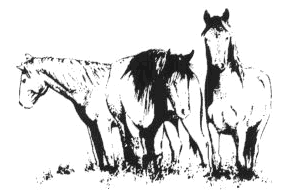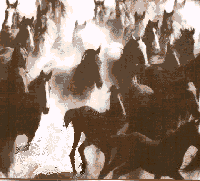Why it is Necessary to Manage Wild Horses
(Images courtesy of BLM and private wild horse enthusiasts.)


Modern wild horses are a non-native species. They were first reintroduced to the North American continent in the 1600s by Spanish explorers. Over the centuries which followed, countless domestic horses either escaped or were intentionally released, formed into bands and the strongest flourished and multiplied. Thus in the scientific sense, these animals are actually feral horses (domestic horses returned to the wild), although for this discussion we will continue to call them "wild horses".
The biggest problem with the wild horses is that as a reintroduced species, nature had not developed all the necessary checks and balances in the ecosystem to deal with them. A healthy horse's only natural predator is the mountain lion (also called cougar or puma). The mountain lion did not range sufficiently or prosper in enough numbers to sufficiently check the growth of the horse herds. In fact, out of thousands of wild horse herds and bands, the mountain lion has been influential in controlling less than a half dozen!

As a result the herds grew and grew, their populations only checked by the supply of food and water. During drought years, thousands of horses would die of thirst and starvation. Thousands more would starve during particularly hard winters. One could argue that water and food were nature's limiting factors, but there is much more to the story.
The wild horses share their habitat with many native animals. They found their way into balanced ecosystems and upset that balance. During lush years, there was enough food and water for all the animals. However, when times were hard, they not only ate much of the food needed by other grazing animals, but they destroyed much of the plant base in their desperate effort to get enough food. Thus, in an unmanaged state, the horses could (and did) have a very negative impact on the ecology of many areas. (See Note 1.)
In the better grazing areas the horses competed with another "introduced species;" beef cattle. The west has had a long standing tradition of growing beef cattle on rangeland. Being more active than cows, horses eat more food. The cattle ranchers are well aware of this fact and therefore for their personal financial interests, they saw a need to keep the growing numbers of horses in check.
Before 1971, there were few controls in place as to how wild horses would be managed. They were considered prairie pests. They were hunted and captured by whomever wanted to go after them. Cowboys known as mustangers would would gather them up by the thousands, oftentimes using cruel methods. A handful would be saved for riding horses and rodeo stock, but the balance would be shipped off to the slaughterhouses.
Around 1958 a Reno, NV secretary named Velma Johnston noticed a trail of blood on the roadway and followed it to a nearby mustanger's truck which was packed with captured horses. The blood was from a foal which had been trampled to death in the truck. This gruesome discovery prompted Velma to embark on a ten year crusade for sensible management and protection of wild and free roaming horses and burros. Legislation was first passed in 1959, however the Wild and Free Roaming Horses and Burros Act of 1971 was the culmination of her efforts. Velma has been affectionately known ever since by wild horse enthusiasts as "Wild Horse Annie." Velma died in 1977, her dream substantially realized.
In reference to horse herds and the environment; in managed numbers the horse herds can actually be beneficial. They graze on non-native grasses and some horses actually dig water holes which the other animals can use. It's when they exist in an overpopulated state that their "menus" must expand and they eat forage and consume water which native wildlife need.
This is not a BLM operated or BLM sponsored site. It is run by private wild horse and burro enthusiasts.
